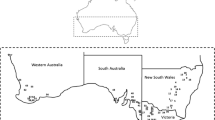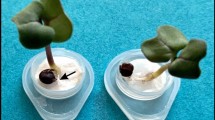Abstract
The infection of above-ground tissues of Brassica napus by Leptosphaeria maculans is well understood. However, root infection (root rot) under field conditions, the development of root rot over time and its relationship to other disease symptoms caused by L. maculans has not been described. A survey of B. napus crops was conducted in Australia to investigate the incidence and severity of root rot. Additionally, the pathway of root infection was examined in field experiments. Root rot was present in 95% of the 127 crops surveyed. The severity and incidence of root rot was significantly correlated with that of crown canker; however, the strength of this relationship was dependent on the season. Root rot symptoms appeared before flowering and increased in severity during flowering and at maturity, a pattern similar to crown canker suggesting that the infection of the root is an extension of the crown canker phase of the L. maculans lifecycle. All isolates of L. maculans tested in glasshouse experiments caused root rot and crown canker in B. napus and Brassica juncea. In the field, the main pathway of root infection is via invasion of cotyledons or leaves by airborne ascospores, rather than from inoculum in the soil. Root rot was present in crops in fields that had never been sown to B. napus previously, in plants grown in fumigated fields, and in glasshouse-grown plants inoculated in the hypocotyl with L. maculans.






Similar content being viewed by others
References
Balesdent, M. H., Barbetti, M. J., Li, H., Sivasithamparam, K., Gout, L., & Rouxel, T. (2005). Analysis of Leptosphaeria maculans race structure in a worldwide collection of isolates. Phytopathology, 95, 1061–1071. doi:10.1094/PHYTO-95-1061.
Ballinger, D., & Salisbury, P. (1996). Seedling and adult plant evaluation of race variability in Leptosphaeria maculans on Brassica species in Australia. Australian Journal of Experimental Agriculture, 36, 485–488. doi:10.1071/EA9960485.
Brun, H., & Jacques, M. A. (1991). Premature ripening in oilseed rape in France: first report on associated fungi. Bulletin SROP, 14, 120–127.
Cresswell, H. P., & Kirkegaard, J. A. (1995). Subsoil amelioration by plant roots—the process and the evidence. Australian Journal of Soil Research, 33, 221–239. doi:10.1071/SR9950221.
Evans, N., Steed, J.M., Fitt, B.D.L., Norman, K., Bryson, R., Alford, J., & Cavell, P. (2003). Preliminary evaluation of root disease of winter oilseed rape in the UK. Home-Grown Cereals Association, Report No. OS62.
Fitt, B. D. L., Brun, H., Barbetti, M. J., & Rimmer, S. R. (2006). World-wide importance of crown canker (Leptosphaeria maculans and L. biglobosa) on oilseed rape (Brassica napus). European Journal of Plant Pathology, 114, 3–15. doi:10.1007/s10658-005-2233-5.
Gibbs, J. G. (1938). A technique for studying the longevity of Phoma lingam in the soil. Phytopathology, 28, 762–763.
Gugel, R. K., & Petrie, G. A. (1992). History, occurrence, impact, and control of blackleg of rapeseed. Canadian Journal of Plant Pathology, 14, 36–45.
Gugel, R. K., Seguin-Swartz, G., & Petrie, G. A. (1990). Pathogenicity of three isolates of Leptosphaeria maculans on Brassica species and other crucifers. Canadian Journal of Plant Pathology, 12, 75–82.
Hammond, K., Lewis, B., & Musa, T. (1985). A systemic pathway in the infection of oilseed rape plants by Leptosphaeria maculans. Plant Pathology, 34, 557–565. doi:10.1111/j.1365-3059.1985.tb01407.x.
Henderson, M. P. (1918). The blackleg disease of cabbage caused by Phoma lingam (Tode) Desmaz. Phytopathology, 8, 379–431.
Hind-Lanoiselet, T.L., Lewington, F., Wratten, N., & Murray, G. (2003). Disease and drought—canola diseases in southern New South Wales and northern Victoria in 2002. Proceedings of Thirteenth Biennial Australian Research Assembly on Brassicas, 109–113.
Hornig, H. (1985). Spatschaden-durch Phoma lingam und Verticillium dahliae?. Raps, 3, 57–58.
Keri, M. (1991). Resistance of Brassica juncea Czern & Coss to blackleg disease caused by Leptosphaeria maculans (Desm.) Ces. et de Not. M.Sc. thesis, University of Manitoba, Canada.
Li, H., Sivasithamparam, K., Barbetti, M., & Kuo, J. (2004). Germination and invasion by ascospores and pycnidiospores of Leptosphaeria maculans on spring-type Brassica napus canola varieties with varying susceptibility to blackleg. Journal of General Plant Pathology, 70, 261–269. doi:10.1007/s10327-004-0125-8.
Li, H., Sivasithamparam, K., & Barbetti, M. J. (2007). Soilborne ascospores and pycnidiospores of Leptosphaeria maculans can contribute significantly to blackleg disease epidemiology in oilseed rape (Brassica napus) in Western Australia. Australasian Plant Pathology, 36, 439–444. doi:10.1071/AP07048.
Marcroft, S. J., Purwantara, A., Salisbury, P. A., Potter, T. D., Wratten, N., Khangura, R., et al. (2002). Reaction of a range of Brassica species under Australian conditions to the fungus, Leptosphaeria maculans, the causal agent of blackleg. Australian Journal of Experimental Agriculture, 42, 587–594. doi:10.1071/EA01112.
Marcroft, S. J., Sprague, S. J., Pymer, S. J., Salisbury, P., & Howlett, B. J. (2004). Crop isolation, not extended rotation length reduces the severity of blackleg (Leptosphaeria maculans) of canola (Brassica napus) in south-eastern Australia. Australian Journal of Experimental Agriculture, 44, 601–606. doi:10.1071/EA03087.
McCully, M. E., Miller, C., Sprague, S. J., Huang, C. X., & Kirkegaard, J. A. (2008). The distribution of glucosinolates and sulphur-rich cells in roots of field-grown canola (Brassica napus). The New Phytologist, 80, 193–205. doi:10.1111/j.1469-8137.2008.02520.x.
Payne, R. W., Harding, S. A., Murray, D. A., Soutar, D. M., Baird, D. B., Welham, S. J., et al. (2007). GenStat Release 10 Reference Manual. Hemel Hempstead, UK: VSN International.
Pang, E. C. K., & Halloran, G. M. (1995). Adaptability and virulence specificity in Australian strains of blackleg [Leptosphaeria maculans (Desm) Ces Et De Not] on different host genotypes of rapeseed (Brassica napus L). Australian Journal of Agricultural Research, 46, 971–984. doi:10.1071/AR9950971.
Punithalingam, E., & Holliday, P. (1972). Leptosphaeria maculans. London, UK: The Eastern Press Ltd.
Purwantara, A., Salisbury, P. A., Burton, W. A., & Howlett, B. J. (1998). Reaction of Brassica juncea (Indian mustard) lines to Australian isolates of Leptosphaeria maculans under glasshouse and field conditions. European Journal of Plant Pathology, 104, 895–902. doi:10.1023/A:1008609131695.
Sosnowski, M., Ramsay, M., Murray, G., Scott, E., & Wilmshurst, C. (2001). Symptoms of blackleg (Leptosphaeria maculans) on the roots of canola in Australia. Plant Pathology, 50, 808. doi:10.1046/j.1365-3059.2001.00631.x.
Sosnowski, M. R., Scott, E. S., & Ramsey, M. D. (2004). Infection of Australian canola cultivars (Brassica napus) by Leptosphaeria maculans is influenced by cultivar and environmental conditions. Australasian Plant Pathology, 33, 401–411. doi:10.1071/AP04045.
Sosnowski, M. R., Scott, E. S., & Ramsey, M. D. (2006). Survival of Leptosphaeria maculans in soil on residues of Brassica napus in South Australia. Plant Pathology, 55, 200–206. doi:10.1111/j.1365-3059.2006.01336.x.
Sprague, S. J., Balesdent, M. H., Brun, H., Hayden, H. L., Marcroft, S. J., Pinochet, X., et al. (2006a). Major gene resistance in Brassica napus (oilseed rape) is overcome by changes in virulence of populations of Leptosphaeria maculans in France and Australia. European Journal of Plant Pathology, 114, 33–40. doi:10.1007/s10658-005-3683-5.
Sprague, S. J., Marcroft, S. J., Hayden, H. L., & Howlett, B. J. (2006b). Major gene resistance to blackleg in Brassica napus overcome within three years of commercial production in southeastern Australia. Plant Disease, 90, 190–198. doi:10.1094/PD-90-0190.
Sprague, S. J., Watt, M., Kirkegaard, J. A., & Howlett, B. J. (2007). Pathways of infection of Brassica napus roots by Leptosphaeria maculans. The New Phytologist, 176, 211–222. doi:10.1111/j.1469-8137.2007.02156.x.
Watt, M., Kirkegaard, J. A., & Rebetzke, G. J. (2005). A wheat genotype developed for rapid leaf growth copes well with the physical and biological constraints of unploughed soil. Functional Plant Biology, 32, 695–706. doi:10.1071/FP05026.
West, J. S., Kharbanda, P. D., Barbetti, M. J., & Fitt, B. D. L. (2001). Epidemiology and management of Leptospaheria maculans (phoma stem canker) on oilseed rape in Australia, Canada and Europe. Plant Pathology, 50, 10–27. doi:10.1046/j.1365-3059.2001.00546.x.
West, J. S., Fitt, B. D. L., Leech, P. K., Biddulph, J. E., Huang, Y. J., & Balesdent, M. H. (2002a). Effects of timing of Leptosphaeria maculans ascospore release and fungicide regime on phoma leaf spot and phoma stem canker development on winter oilseed rape (Brassica napus) in souther England. Plant Pathology, 51, 454–463. doi:10.1046/j.1365-3059.2002.00726.x.
West, J. S., Balesdent, M. H., Rouxel, T., Narcy, J. P., Huang, Y. J., Roux, J., et al. (2002b). Colonization of winter oilseed rape tissues by A/Tox+ and B/Tox0 Leptosphaeria maculans (phoma stem canker) in France and England. Plant Pathology, 51, 311–321. doi:10.1046/j.1365-3059.2002.00689.x.
Acknowledgements
This research was supported by the Australian Grains Research and Development Corporation. We acknowledge the assistance of Chris Duff, John Sykes, Geoff Pitson and Greg Condon for the collection of B. napus plants for the survey and John Graham (CSIRO Plant Industry) for data collection. We also acknowledge the statistical advice provided by Alec Zwart (CSIRO Plant Industry).
Author information
Authors and Affiliations
Corresponding author
Rights and permissions
About this article
Cite this article
Sprague, S.J., Howlett, B.J. & Kirkegaard, J.A. Epidemiology of root rot caused by Leptosphaeria maculans in Brassica napus crops. Eur J Plant Pathol 125, 189–202 (2009). https://doi.org/10.1007/s10658-009-9470-y
Received:
Accepted:
Published:
Issue Date:
DOI: https://doi.org/10.1007/s10658-009-9470-y




